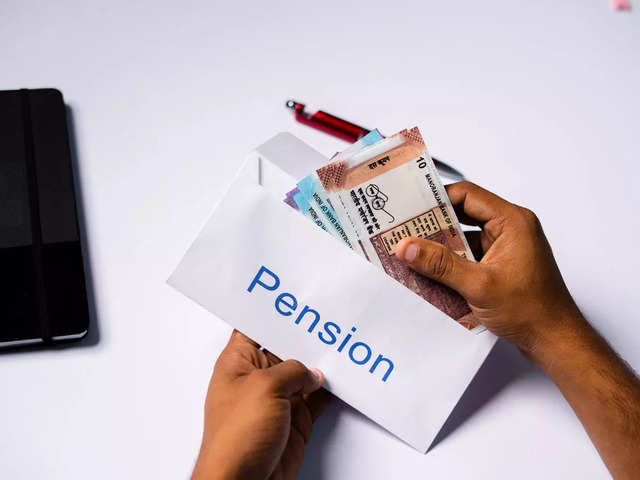
With demand for the old pension system (OPS) with assured benefits growing, the government on Friday announced the formation of a committee under the direction of the finance secretary TV Somanathan to examine ways to save the pension reforms by choosing a middle ground between the unpopular National Pension System (NPS) and the fiscally irresponsible OPS.
"There have been complaints that the government employees' NPS needs to be addressed. Nirmala Sitharaman, the finance minister, said to the Lok Sabha, "I propose to set up a committee under the finance secretary to look into the pension issue and develop an approach, which addresses the needs of employees while maintaining fiscal prudence to protect common citizens. "The strategy will be created for both the federal government and state governments to embrace."
Subsequently, Somanathan stated that the panel will attempt to allay the worries of all stakeholders and investigate any problems brought up by any source. There has been no announcement on the panel's composition, members, or terms of reference.
According to sources, one possibility would be to modify the current programme without placing an undue financial strain on the exchequer to provide guaranteed pensions to government employees at a rate of around 50% of the final income received under the NPS. Nevertheless, it may be graded, with a 40% pension for those who have at least 20 years of service and a 50% pension for those who have at least 30 years.
Whereas the NPS is founded on the concept of defined contribution, the OPS is based on the idea of defined benefits.
The Center is aware of the growing resonance of demand for the OPS amid a spate of state/general elections in 2023–2024. However, it has ruled out rolling back the pension reforms and returning to the financially disastrous unfunded OPS, which entails 50% of the last pay drawn as pension from the budget to the pre–2004 staff.
Numerous Opposition-ruled states, including Punjab, Chhattisgarh, Rajasthan, and Jharkhand, have declared their intention to rejoin the OPS. After assurances from chief minister Eknath Shinde that OPS benefits will be incorporated in the NPS, almost 1.7 million employees of the BJP-Shiv Sena-led Maharashtra government recently called an end to their prolonged protest over the OPS.
Presently, the NPS allows for the withdrawal of 60% of the corpus that has been accrued as a result of contributions made during a person's working years. A similar withdrawal is tax-free. The remaining 40% is invested in annuities, which, on average, might offer benefits equal to around 35% of the last paycheck received. Nevertheless, because returns are based on the markets, it is not a guaranteed pension.
According to officials, the NPS might be changed such that a retiree receives a lump sum payment equal to her contribution, which is now 41.7% (constructed from a contribution of 10% of income).
Our study revealed that the pension in the NPS may be close to 50% of the last collected pay if the balance 58.3% corpus established from the Central/state government contribution (14%) is annualised. If actual returns are less than the promised amount, the gap might be filled by the concerned government by making a small additional contribution to the NPS.

 🕑 28 Oct, 2025 04:46 PM
🕑 28 Oct, 2025 04:46 PM
8th Pay Commission constituted. ToR Approved, Effectively Jan 2026
 🕑 02 Jul, 2025 10:03 AM
🕑 02 Jul, 2025 10:03 AM
Commutation Relief In Sight? Panel Likely To Review 15-Year Deduction Rule
 🕑 12 Jun, 2025 08:12 AM
🕑 12 Jun, 2025 08:12 AM
8th Pay Commission: Uncertainty Looms as Employees Await Terms of Reference
 🕑 24 Apr, 2025 10:21 PM
🕑 24 Apr, 2025 10:21 PM
Staff Side constitutes panel for drafting memorandum to 8th CPC when formed
 🕑 24 Apr, 2025 10:17 PM
🕑 24 Apr, 2025 10:17 PM
8th Pay Commission likely to be set up by mid May
 🕑 09 Apr, 2025 10:27 AM
🕑 09 Apr, 2025 10:27 AM
Loan EMIs to get Cheaper as RBI cuts Repo Rate sgain | See the benefit
 🕑 09 Jun, 2025 08:25 AM
🕑 09 Jun, 2025 08:25 AM
📢 UPS vs NPS: The Retirement Dilemma Facing 27 Lakh Government Employees
 🕑 04 Apr, 2025 04:46 PM
🕑 04 Apr, 2025 04:46 PM
NPS To UPS Switch from April 1: A Detailed Look at the Option to Switch
 🕑 30 Mar, 2025 11:01 AM
🕑 30 Mar, 2025 11:01 AM
8th Pay Commission implementation may get delayed till 2027 – Here’s why
 🕑 27 Mar, 2025 10:25 PM
🕑 27 Mar, 2025 10:25 PM
7th CPC wanted a permanent pay panel, end DA revision twice
 🕑 27 Mar, 2025 08:43 AM
🕑 27 Mar, 2025 08:43 AM
8th Pay Commission: What Kind Of Salary Hike Can Be Staff Expected?
 🕑 20 Mar, 2025 08:24 AM
🕑 20 Mar, 2025 08:24 AM
Why the commuted pension is restored after 15 years, not 12 years
 🕑 17 Mar, 2025 08:37 AM
🕑 17 Mar, 2025 08:37 AM
📈 Expected Dearness Allowance (DA) from January 2026 Calculator